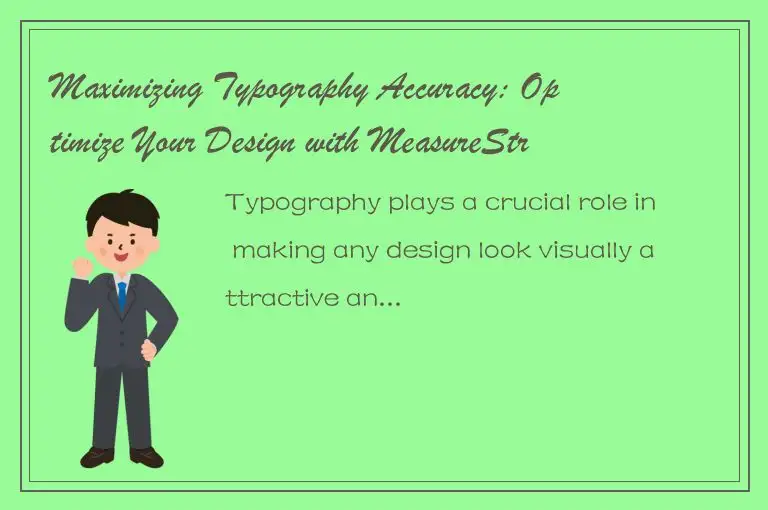Typography plays a crucial role in making any design look visually attractive and easy to understand. While there are multiple techniques and tools that designers use to enhance the typography of their designs, MeasureString is one of the most efficient methods to optimize typography accuracy.

MeasureString is a built-in function in .NET and C# language that allows designers to measure the dimensions of the string, including the width and height of the text contained within a certain rectangle. This function is particularly useful in situations where designers need to fit text perfectly within a confined space, such as in posters, advertisements, and brochures.
In this article, we will discuss how MeasureString works and how designers can use it to maximize typography accuracy in their designs.
How MeasureString Works
As mentioned earlier, MeasureString is a built-in function in .NET framework that allows designers to measure the width and height of a string's contents. This function takes a string and a font object as its input and returns a SizeF object that represents the dimensions required to fit the string.
The following is the syntax of the MeasureString function in C# language:
```
public SizeF MeasureString(
string text,
Font font
)
```
Here, the text parameter represents the string that needs to be measured, and the font parameter represents the font that the text is written in.
Designers can use this function to measure the size of a text string in various units, such as pixels, points, millimeters, etc., by specifying the measuring unit in the Graphics object.
How to Use MeasureString to Maximize Typography Accuracy
To maximize typography accuracy using the MeasureString function, designers need to follow a few essential steps, including:
Step 1: Choose the Right Font
Choosing the right font is the first step in optimizing typography accuracy using MeasureString. The font should be legible and visually appealing so that the text is easy to read and understand. It is also essential to consider the size and style of the font and how it will affect the overall design.
Step 2: Set the Size of the Text Box
After selecting the font, designers need to create a rectangle representing the text box where they want to fit the text. This rectangle can be created using the RectangleF class in C#, which allows designers to specify the position and size of the text box.
Step 3: Use MeasureString to Determine the Size of the Text
Once the font and text box have been set, designers can use the MeasureString function to determine the exact size of the text that will fit in the given rectangle. Designers can then adjust the font size, line spacing, or word spacing accordingly to optimize the typography accuracy.
Step 4: Implement the Measured Text into the Design
Finally, designers can implement the measured text into the overall design, ensuring that the typography is accurate and visually appealing.
Benefits of Using MeasureString to Maximize Typography Accuracy
Using MeasureString to optimize typography accuracy offers several benefits, including:
1. Improves readability: Accurately measuring the size of the text can help designers adjust the font size and other parameters to enhance readability, making the text easy to read and understand.
2. Saves time and effort: Using MeasureString eliminates the need for manual measurement, which can be time-consuming and prone to errors.
3. Ensures consistency: By using MeasureString, designers can ensure that the typography is consistent throughout the entire design, resulting in a more professional and cohesive look.
Conclusion
In summary, MeasureString is an efficient and reliable method that designers can use to maximize typography accuracy in their designs. By following the steps outlined above, designers can ensure that their typography is legible, visually appealing, and consistent, resulting in a high-quality and professional-looking design.




 QQ客服专员
QQ客服专员 电话客服专员
电话客服专员